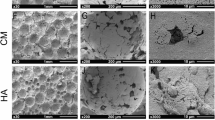Abstract
The response to implantation of novel apatite glass–ceramics was evaluated using a weight bearing in vivo bone implant model. Five novel glasses with varying calcium to phosphate ratios were cast as short rods and heat-treated to crystallize principally apatite. One glass ceramic had an apatite stoichiometry (Ca : P=1.67); three were phosphate-rich and one calcium-rich. One of the phosphate-rich glasses was also tested in its glassy state to determine the effect of crystallization on the biological response. Rods were implanted into the midshaft of rat femurs and left for 28 days. The femurs were then harvested and processed for scanning electron microscopy, energy dispersive X-ray microanalysis and conventional histology as ground and polished sections. Four of the materials exhibited evidence of osseointegration and osteoconduction. However, there was a marked inflammatory response to one of the phosphate-rich glass–ceramics, and to the non-crystallized glass. Crystallization of the latter significantly improved the bone tissue response. The glass–ceramic with an apatite stoichiometry elicited the most favorable response and merited further study as an osteoconductive bone substitute in maxillofacial and orthopedic surgery.
Similar content being viewed by others

References
A. Rafferty, A. Clifford, R. Hill, D. Wood, B. Samuneva and M. Dimitrova-Lukacs, J. Am. Ceram. Soc. 83 (2000) 2833.
K. K. Johal, G. Mendoza-Suarez, J. I. Escalante-Garcia, R. G. Hill and I. M. Brook, J. Mater. Sci. Mater. Med. 13 (2002) 375.
R. T. Ramsden, R. C. D. Heardman and R. H. Lyle, J. Laryng. Otol. 106 (1992) 949.
A. Johnson, M. Y. Shareef, J. M. Walsh, P. V. Hatton, R. Van Noort and R. G. Hill, Dent. Mater. 14 (1998) 412.
A. Clifford, R. G. Hill, A. Rafferty, P. Mooney, D. Wood, B. Samuneva and S. Matusuya, J. Mater. Sci.: Mater. Med. 12 (2001) 461.
A. Clifford, R. G. Hill, M. J. Towler and D. J. Wood, J. Mater. Sci. 36 (2001) 3955.
C. Maniatopoulos, A. Rodriguez, D. A. Deporter, D. Perio and A. H. Melcher, Int. J. Oral Maxillofac. Implants 1 (1986) 31.
L. A. Salata, G. T. Craig and I. M. Brook, ibid. 13 (1998) 44.
P. Ducheyne and Q. Qui, Biomaterials 20 (1999) 2287.
H. Carter, P. Sloan, I. M. Brook and P. V. Hatton, ibid. 18 (1997) 459.
J. C. Knowles and W. Bonfield, J Biomed. Mater. Res. 12 (1993) 1591.
Author information
Authors and Affiliations
Corresponding author
Rights and permissions
About this article
Cite this article
Freeman, C.O., Brook, I.M., Johnson, A. et al. Crystallization modifies osteoconductivity in an apatite–mullite glass–ceramic. Journal of Materials Science: Materials in Medicine 14, 985–990 (2003). https://doi.org/10.1023/A:1026306901058
Issue Date:
DOI: https://doi.org/10.1023/A:1026306901058



